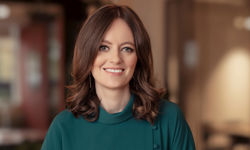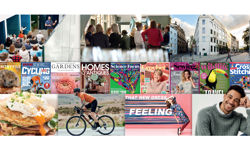Once upon a time, glossy magazines reported from catwalk shows and their monthly diktats filtered down to inform what mere mortals shopped for on the high street.
Now, there is a multitude of platforms offering fashion inspiration – from online retailers such as ASOS delivering regular edits to your inbox, to fashion bloggers such as Susie Lau (aka Style Bubble) and Chiara Ferragni (aka The Blonde Salad).
So how does a brand like Look – which launched a decade ago as a weekly fashion magazine focusing on the high street, a revolutionary concept at the time - cut through the noise and continue to make itself relevant to its target audience of 18 to 34-year-old women?
Editor Gilly Ferguson believes her readers are still looking for a voice they can trust to lead them through the fashion jungle.
“We’ve got the scale and authority of being a trusted brand that’s been around for ten years, but we speak to our audience in a non-patronising way, like a fashionable best friend.”
Four pillars
Even as a credible brand, it is vital to keep on changing with the fast-paced online fashion world, which is why in September, Look revealed a new brand strategy, based around four pillars: Fashion, Beauty, Life and Fitness, which provide a backbone to all of its content online and in print.
Rather than expect the audience to come to the magazine, Look’s approach is to be wherever the audience is - whether that is on Instagram, Snapchat, Facebook or Twitter. Key to this is the brand’s network of ‘Look Influencers’, individuals who have their own following in the fashion and beauty world and act as digital spokespeople for the magazine.
Ferguson explains that the network of Look Influencers is tiered: “There are the big household name influencers such as Deliciously Ella and Rosie Fortescue. Then there are the micro-influencers. We have found that the fewer followers they have, the more our readers relate to them. People with less than 1,500 followers have an engagement of 25%.”
Are any of the influencers remunerated for their services? “I don’t want to talk about payment, but there is a real desire from them,” says Ferguson.
Readers are also offered the chance to become influencers through entry points such as #LWIW (Look What I’m Wearing). Ferguson reveals: “The editorial team select their favourites. Each week, someone wins ‘Look of the Week’ and the best will be signed up as fashion influencers.” They have also been experimenting with a ‘gaming style’ system where readers are invited to send in tips, which other users can rate to say which have been most useful. The most popular may then be invited to become influencers.
Live events are another important part of the mix. The redesigned magazine - which has been given more of a premium feel, while still featuring affordable fashion - was distributed for free at five shopping centres around the UK and at Student Lock-In events during university freshers’ weeks. Ferguson reveals that ‘experientials’ is a growing area with events such as high street catwalks and in-store beauty tutorials designed to reinforce the idea of Look as “the audience’s best friend”.
Brand voice
Keith Walker, digital director for the Innovation Group at Time Inc, who is responsible for helping Look, Now and NME expand their online reach to millennials, says: “People believe people, so brand voice is really important. You need a certain tone and a directness and honesty in communication at all times, and you need to stay true to that tone.”
Look has a monthly brand footprint (unique users, Twitter followers and Facebook likes) of 3.8m, while reach (the total number of people who see their content) is around 5.6m a month. The title is aiming for a 20% uplift in its digital audience, while “still acknowledging that we have this beautiful print product which is our ace”, according to Ferguson.
The brand’s strategy is to pursue a disaggregated content model, moving beyond the traditional print product and website. “It became very clear in the research that it’s no good limiting yourself to delivering the content to where you want the audience to be. If the audience are on Instagram, Twitter or Snapchat, that’s where you need to be,” Walker emphasises.
Content choices
Organising content around four pillars is a way to achieve coherence in this fragmented landscape. The first two pillars – Fashion and Beauty – were an obvious choice for the Look brand. Walker reveals that the Fashion vertical is viewed by the audience as a source of inspiration and entertainment. He says: “For example, we have a regular feature where the team selects new pieces that are on trend from different high street retailers such as H&M and River Island. The audience see that as entertainment; they’ll flick through on their phones and save to a wish-list.” However, readers have a more utilitarian approach to beauty: “How do I contour my face if I’ve got a square face or a heart-shaped face?”
The final two pillars – Fitness and Life – were more of a new direction. Look Fitness plugs in to the trend for fitness fashion – “this is what you wear to look really cool at the gym” – and is highly data driven – “we seeded the content online to see if there was an appetite”.
Look Life grew out of research done by Time Inc into the need felt by women in their 20s for life advice: “How do you deal with stress in the workplace? How do you get through the day if you haven’t had enough sleep? Young people today are much more career-focused than the generation before them. There is a real appetite for utility content,” Walker reveals.
Look has recently recruited a dedicated videographer to the team, who creates both “evergreen poised video” and “rough and ready Facebook Live videos”. According to Ferguson, “it’s about having a reliably consistent stream of video, not worrying so much about creating a feature length film”. To stand out from the crowd, Look is creating bespoke videos such as beauty tutorials tailored to different face shapes. Ferguson also illustrates how social media can be used to create content for other platforms: “We are using Snapchat to do celebrity Q&As, turning that into video and then using the strap-lines in print.”
Tracking reader preferences
Ferguson and her team are constantly analysing digital feedback to work out what content is popular and using those insights to inform editorial decisions. For example, online data might show a surge in people reading about coats on the first cold day of the year, so they will run features on coats on the website and in print.
“We chart the journey in our readers’ day. We know they love looking at skincare and beauty at night and they shop quite late in the evening. All our content is targeted at these touch-points. Our deadlines are a lot more reactive than they have been over the last ten years. Content works across each platform and we treat it as one big brand instead of separately,” says Ferguson.
As well as this meta-data, Look uses The Lab at Time Inc, where focus groups of five or six young women talk about what they want from a magazine brand. The ideas they come up with are then tested online to see which strike a wider chord.
The commercial angle
The commercial team was closely involved with the redesign. “Our clients want to connect with the next generation of customers. They want a reliable, authentic way of connecting with a millennial audience,” says Walker.
Andrew Sanders, commercial director for the Innovation Group, says, “it all comes down to being able to gain a huge amount of impact across a wide variety of platforms and channels for commercial partners.” He adds: “We’ve seen a huge shift from straightforward display into native content and bespoke editorial.” The Foundry, Time Inc’s in-house sponsored content unit, works closely with the Look editorial team to produce native advertising that appeals to the brand’s audience. Sponsored content mainly falls into one of two categories - articles or features that have been specifically commissioned by a client, or sponsorship of an existing editorial vehicle, for example, at launch, Look Life was sponsored by beauty brand Neutrogena.
“We are constantly refining the way we are talking to our audiences. We can bring a huge amount of audience understanding to bear,” insists Sanders. He adds: “Advertisers are really excited to work with us because we can plug them into that younger segment in a way that we know they are going to respond to. It’s that constant process of reinvention that makes us interesting for commercial partners. This audience is pretty hard to reach. They consume content in a very disaggregated way, so we are now disseminating content in a disaggregated way, but we can still maintain that brand impact and trust.”
Which brings us back to who can be trusted in the crowded world of fashion commentary. Speaking in the aftermath of the spat between the editors of US Vogue and fashion bloggers, Ferguson believes: “There are some incredible bloggers out there. There is no reason why we can’t work together. It’s just doing it in a way that we are all happy with. Our audience still want the authority and still have respect for brands like Look.” She adds: “We’re working with the best influencers and experts, creating the best content and stories. Bloggers aren’t going to go anywhere. There’s lots they do that publishing houses could learn from and vice versa.”












